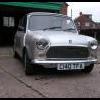Thought I'd update this a bit, as the car is now on the road :) Going to skip some of the more boring bits :)
Got the Fiesta calipers fitted

After scouring eBay for several months I eventually managed to get hold of a fitting kit for the calipers, which gave me the brown piece in the picture. Two of these are used on each caliper to fix it to the bracket and allow it to slide when applying the brakes. I couldn't find these anywhere else, including Ford. The fitting kits I could find for the mark 1 were only the anti rattle spring bits used to fix the pads to the caliper bracket.
Also had to use a washer between the caliper and bracket, as others have, to stop the bracket getting too close to the disc. Calipers were rebuilt with new seals too.
Had a road trip down to MiniSpares and picked up the tyres, dampers and a few little bits and pieces. The dampers are the Kayaba gas variety that MiniSpares do in a nice set of four for a very reasonable sum.
At the front also fitted new pins at the bottom and new upper brackets of the lowered variety. Managed to bugger up the threads on the originals when removing the old dampers all those years ago.
Then moved on to rebuilding the engine, which was stripped down. The gearbox was ok bar a stripped thread on the diff output cover, this was fixed with a helicoil repair kit. A bit of an exercise in drill control and not getting the hole at a daft angle but it turned out ok.

The stripped thread was discovered as the diff output bushes were worn resulting in some considerable play in the output shafts. New bushes were knocked in, which was easy enough, however they also need to be reamed to size to suit the output shafts. After giving up with trying to hone them out to size, ebay came to the rescue with a set of second hand imperial reamers for £10. Sorted. New output seals went in too as no doubt the old ones were knackered with the shafts moving around so much. Last job on the box was a gear selector seal kit.
Decided to pop a couple of bearing caps off the crank just to check the condition of the engine. Unfortunately they weren't looking too good and the quick decoke plan went out of the window. Plan B was to dismantle everything and sort it out properly.
The list of replacement bits got quite big in the end; new cam bearings, mains, big ends and piston rings were needed. New crank thrust bearings too as the end float was way off spec. The timing chain was ok but needed a new tensioner and timing cover seal. Here we are half way through putting the pistons back in the newly honed bores.

the engine block, gearbox and clutch housing were all fitted back together and the block given a coat of paint. Then borrowed an engine crane and dropped it into the bay. One problem with the block was a stripped thread on the rear engine steady bolt. The first plan was to helicoil, until I discovered Mini Spares sell a range of replacement brackets that get around having one or more of these threads being unserviceable. Plus they were slightly cheaper than buying a helicoil kit. Here it is fitted.

This picks up on two of the transfer housing bolts for the additional support needed. The rear bolt screws into a captive nut on the bracket, not into the broken thread in the block.
Made up a simple plate to hold the clutch onto the transfer housing . This angles the coil to clear the air duct. I never liked the original coil bracket, hanging it off one of the head studs.

The cylinder head was stripped down next, cleaned up and dismantled. This just needed a good decoke and a quick going over with a valve seat cutter to clean the seats up nicely. One exhaust valve was quite badly corroded and so will need replacing, just waiting for a new one to be delivered before the head can be fitted.
The thermostat bypass hole was also plugged up on the head. This is a common failure point that I wanted to eliminate, as it was on the later Mini's and the Metro. I made sure the new water pump was a later one which doesn't have the corresponding nozzle on it for a start then attacked the head.

This would have had the nozzle for the bypass hose originally. The nozzle in screwed into the head, but expected it was corroded into place from years of being immersed in coolant; the nozzle just broke off when trying to unscrew it. Plan B was then to remove the remains of the nozzle until it was flush with the head, tap the hole and screw in a plug. In this case a 1/2 inch UNC tap and a cut down bolt were used, with plenty of thread lock to help it seal. Fingers crossed it doesn't leak!










































